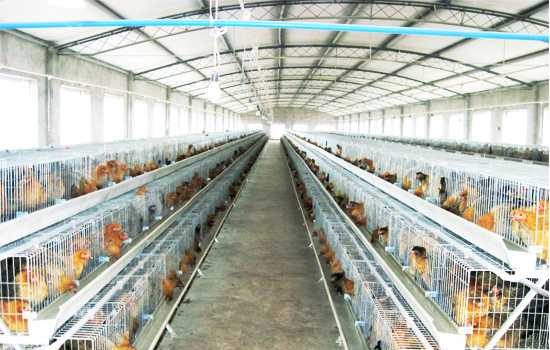Feeding and management of chickens in laying hen cages during laying period
- font size decrease font size increase font size
The layer hen cages are kept at all stages of the laying period. According to the laying stages of laying hens, it is divided into pre-laying period, mid-laying period and late-laying period. Next, we will bring you the feeding and management of each stage of layer cage breeding.
Early stage of laying. Usually, 21-24 weeks of age is the expected date of delivery, and adult chickens are transferred from the ground to the three-dimensional cage of the laying hen house. At this point, the pre-installed paper feeding starts. The calcium content in the diet should be increased from 1% to 2%. During this period, the chicken's ovaries and secondary sexual characteristics developed rapidly, and the feed intake increased significantly. It must be allowed to eat freely to meet its nutritional needs. At present, there are two ways to provide nutrition to laying hens: one is to adjust the supply of nutrients in the diet according to the gradual increase in egg production rate. The other is to start as early as possible when the egg production rate reaches 5-10%. At this stage, Newcastle disease, avian influenza, egg drop syndrome and other vaccines should also be vaccinated in accordance with the immunization program to prevent postpartum immunization from affecting egg production.

Mid-laying period. 25-42 weeks of age is the mid-laying period. Under normal management conditions, the egg production rate of 23-24 weeks old chickens should reach 50%. During this period, the egg production rate will increase rapidly. Reach the peak period of egg production. The main task during the peak period of egg production is to maintain the stability of nutrient supply and the consistency of management work, avoid various stress factors, except for the breeding staff of the chicken house, other personnel are not allowed to enter the chicken house. The color of the breeder's clothes is relatively fixed, and materials, water or electricity cannot be cut off. The temperature must be uniform and appropriate, especially the environment must be quiet.
Late laying period. 43-72 weeks of age is the late stage of laying, and protein supply should be adjusted appropriately according to the drop in laying rate. Generally, when the egg production rate exceeds 85%, the daily protein intake of each chicken is 18 grams; when the egg production rate drops to 80-75%, the daily protein intake of each chicken is reduced to 16 Gram; When the egg production rate drops to 70-65%, each chicken needs to eat 14 grams of protein per day. In addition, due to the hot summer weather, the appetite of laying hens is reduced and the feed intake is reduced. Therefore, the protein level in the diet should be appropriately increased. Winter is cold, and the energy required to maintain body temperature increases. Therefore, the metabolizable energy level of the feed should be appropriately increased to avoid affecting the egg production rate.
The above is the management of the early, middle and late stages of laying eggs in the shared layer cage. Farmers must not only strengthen the management of the chicken house, but also play the role of automatic chicken raising equipment to make chicken raising a relaxed and happy thing.

